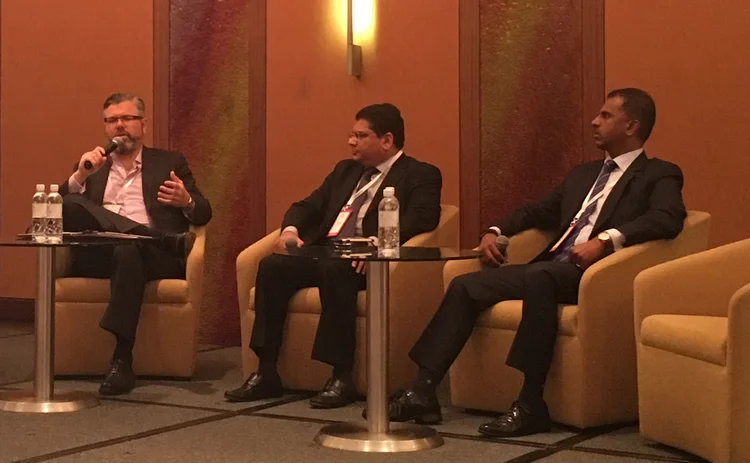Panelists: Get the Data Right Before Worrying About Next-Gen Technology
Buy-side firms are being pulled into two different directions by legacy applications and innovative new tools, noted panelists at this year's Asia-Pacific BST Summit.

Technologists are always being pulled in two directions. On the one hand, they’re having to oversee the nuts and bolts of legacy systems and make sure that operations are running smoothly. At the same time, they also have to keep an eye on the future and examine new and potentially disruptive technologies.
While the latter is sexier, banks must never look too far ahead that they lose sight of present-day needs, noted Martin Leo, executive director of risk management for Morgan Stanley Investment Management, who spoke on a panel at this year’s Asia-Pacific Buy-Side Technology Summit.
“We’ve got legacy applications that are pulling us behind,” Leo said. “I wouldn’t go very far and look at artificial intelligence; I think that’s really far and we have a long way to go to get there. I think the bigger challenge is to be able to get our datasets right. Do we have a golden source of data that we can rely on for our applications? Then we take the next step of being able to visualize and then take it and monetize it. The moment you have data that is clean and meaningful,” you can take those next steps, he said.
Meanwhile, on the buy side, Rob Scott, head of international operations and head of technology and operations for Nikko Asset Management’s Asia unit, ex-Japan, said that compared to other industries, the asset management space has room for improvement when it comes to deploying innovative technologies. But like the sell side, it’s true for all firms that they must first get the data right.
“We’re still trying to get good sets of data to then try and utilize some of those new tools off the back of that. Even the business analytics tools that some of the vendors roll out—tools that all businesses use—we don’t even have the datasets ready to utilize that properly,” he said.
Scott added that technologies like blockchain, predictive analysis, and robo-advisors, among others, are on the periphery, but a lot of time and effort is focused on trying to comply with regulatory requirements, which is reliant on good data.
Technology as an Enabler
And then there’s wealth management. Venkatesh Narasiah, COO of Asia-Pacific for assets and wealth management at Deutsche Bank, said the key for managers is to harness the data for clients and then provide them with tools to create a more well-rounded investment ecosystem between the managers, the advisors and the clients.
“If we look at next-gen technology, for the private banks, I think it’s enablement with a capital ‘E’—enablement for the relationship managers, the investment advisors and for the clients themselves,” he said. “Can you get information at your fingertips on trade ideas for your clients? It’s not like if you’re a relationship manager you need to get an investment advisor—which then becomes subject to their own views coming to it rather than pure objective views on what’s available in the market—and then come up with a menu and then fit that with the client’s choices and then offer that to the client. I think that stuff is becoming important.”
The Norm of New Regulations
Another impediment to looking ahead to next-gen tools—perhaps the greatest current impediment—is regulation. New regulatory reporting demands and stricter trading rules are forcing firms on the buy side and sell side to focus their budgets on those mandates rather than dumping money into research and development.
“I think it’s part of the norm that at any given time, we are dealing with a range of new regulatory requirements that we have to implement,” Scott said. “Unfortunately, we spend too much time on it rather than the funky tech stuff or trying to grow the business—but it’s the state of play and it’s going to be the same for the foreseeable future.”
And as Narasiah noted, new rules have siphoned off money that could go toward new project implementations. He said that, in general, regulatory demands take up about 25 to 33 percent of the technology budget, whereas previously that number was closer to 10 percent.
“Your fixed costs have gone up tremendously,” he said. “What it has also done in the industry is that firms that have been profitable but did not have scale suddenly come very close to the break-even point or they start finding that they are taking losses. Their net income is negative as a result of fixed costs going up. The result of that in the industry is massive consolidation because if you want to be profitable in the market you need to have scale. And to get scale you need market share.”
The Bottom Line
Morgan Stanley’s Leo said that the time will come when the industry will be set to fully embrace machine learning and cognitive tools. The first waves of success will likely come around reducing the element of error and finding red flags. From there, AI will help firms to predict things like customer behavior, investment performance or risk. “I think that would be a very good next-gen jump,” Leo said.
And maybe fintech firms can help bridge that gap. But, as Nikko’s Scott noted, there’s still a wariness that exists around this community of startups. “Most of us are still generally going with the brands we know and can trust. If you take a risk and go with a fintech and the technology goes wrong, you’re stuffed,” Scott said. “If it goes right you’re a hero and the solution might be funkier and might be cheaper, but you’re taking that risk. Obviously, if you go with a known brand, it costs a bit more and maybe the tech is not as cool or as funky, but it’s more of a surety.”
Only users who have a paid subscription or are part of a corporate subscription are able to print or copy content.
To access these options, along with all other subscription benefits, please contact info@waterstechnology.com or view our subscription options here: http://subscriptions.waterstechnology.com/subscribe
You are currently unable to print this content. Please contact info@waterstechnology.com to find out more.
You are currently unable to copy this content. Please contact info@waterstechnology.com to find out more.
Copyright Infopro Digital Limited. All rights reserved.
As outlined in our terms and conditions, https://www.infopro-digital.com/terms-and-conditions/subscriptions/ (point 2.4), printing is limited to a single copy.
If you would like to purchase additional rights please email info@waterstechnology.com
Copyright Infopro Digital Limited. All rights reserved.
You may share this content using our article tools. As outlined in our terms and conditions, https://www.infopro-digital.com/terms-and-conditions/subscriptions/ (clause 2.4), an Authorised User may only make one copy of the materials for their own personal use. You must also comply with the restrictions in clause 2.5.
If you would like to purchase additional rights please email info@waterstechnology.com
More on Emerging Technologies
Standard Chartered goes from spectator to player in digital asset game
The bank’s digital assets custody offering is underpinned by an open API and modular infrastructure, allowing it to potentially add a secondary back-end system provider.
Saugata Saha pilots S&P’s way through data interoperability, AI
Saha, who was named president of S&P Global Market Intelligence last year, details how the company is looking at enterprise data and the success of its early investments in AI.
Data partnerships, outsourced trading, developer wins, Studio Ghibli, and more
The Waters Cooler: CME and Google Cloud reach second base, Visible Alpha settles in at S&P, and another overnight trading venue is approved in this week’s news round-up.
Are we really moving on from GenAI already?
Waters Wrap: Agentic AI is becoming an increasingly hot topic, but Anthony says that shouldn’t come at the expense of generative AI.
Cloud infrastructure’s role in agentic AI
The financial services industry’s AI-driven future will require even greater reliance on cloud. A well-architected framework is key, write IBM’s Gautam Kumar and Raja Basu.
Waters Wavelength Ep. 310: SigTech’s Bin Ren
This week, SigTech’s CEO Bin Ren joins Eliot to discuss GenAI’s progress since ChatGPT’s emergence in 2022, agentic AI, and challenges with regulating AI.
Microsoft exec: ‘Generative AI is completely passé. This is the year of agentic AI’
Microsoft’s Symon Garfield said that AI advancements are prompting financial services firms to change their approach to integrating AI-powered solutions.
Inside the company that helped build China’s equity options market
Fintech firm Bachelier Technology on the challenges of creating a trading platform for China’s unique OTC derivatives market.








